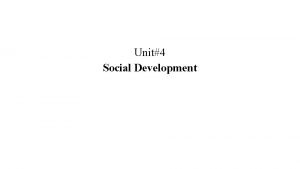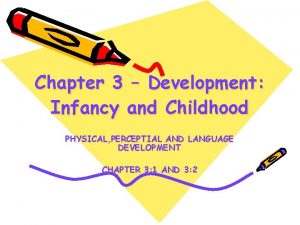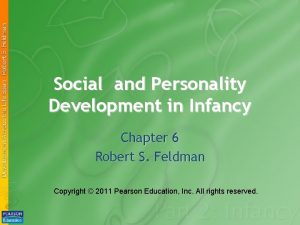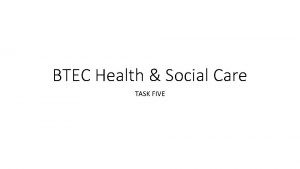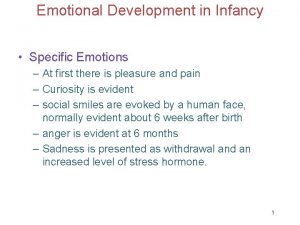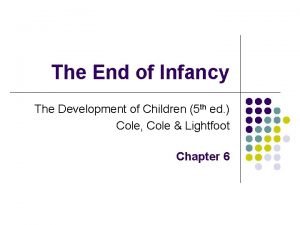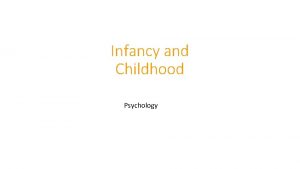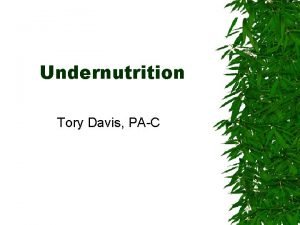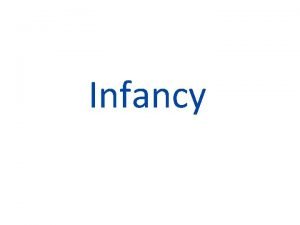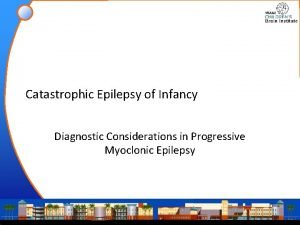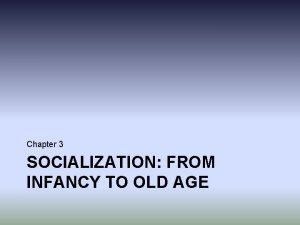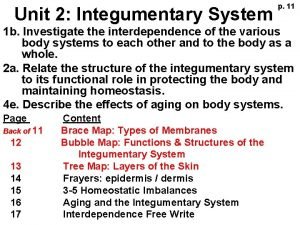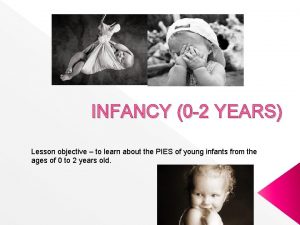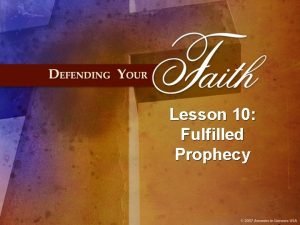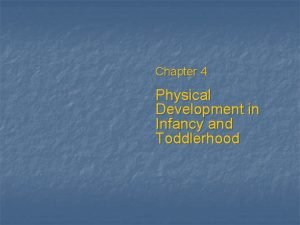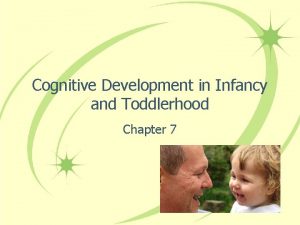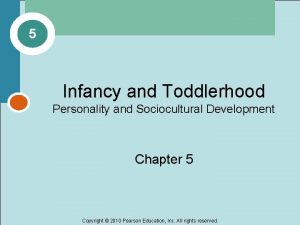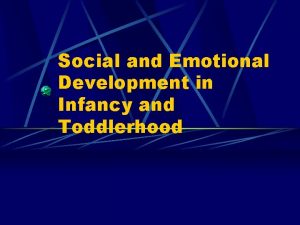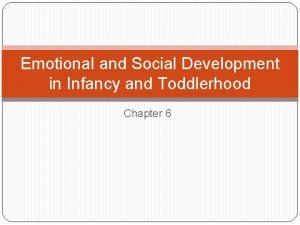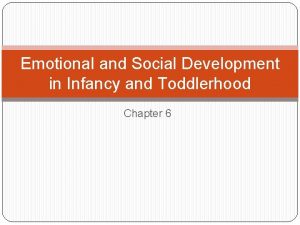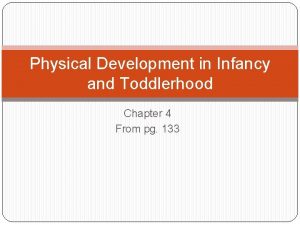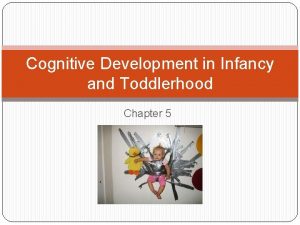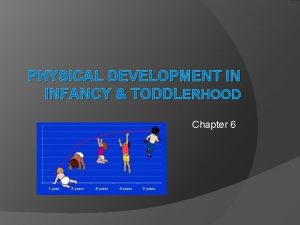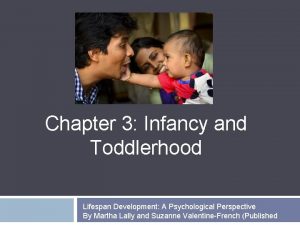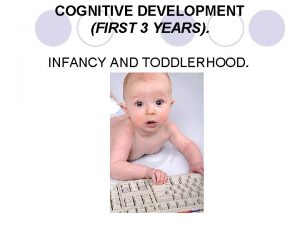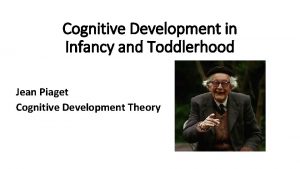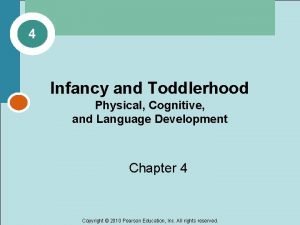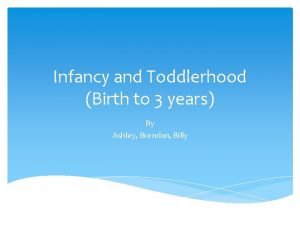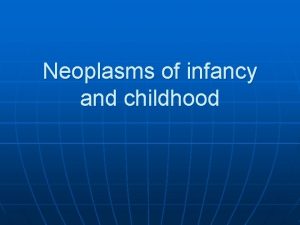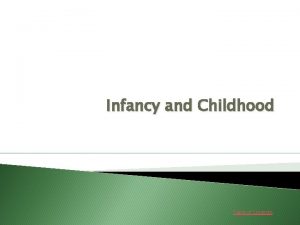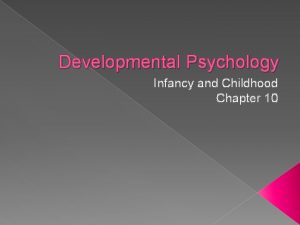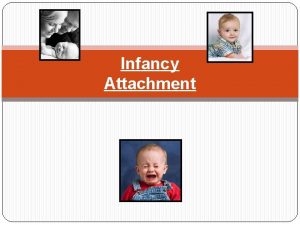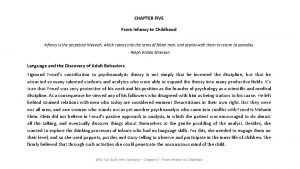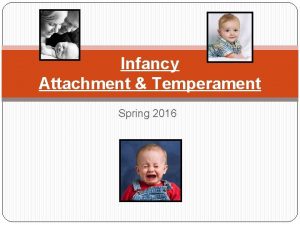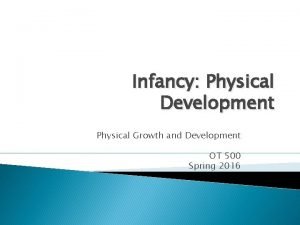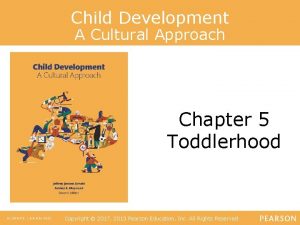Infancy Toddlerhood Unit 3 Growth Development Growth is




































- Slides: 36

Infancy & Toddlerhood Unit 3

Growth & Development Growth is defined as physical changes Development is defined as a combination of physical changes and cognitive advances

Physical Development Newborns have 3 major developmental abilities: ◦ Reflexive Behavior Coughing Blinking ◦ Inherited Behaviors Temperament Crying ◦ Motor Skills Developed in a stage-like fashion based on muscle anatomy and neural development/coordination

The Nerve Cell 3 Basic Parts: ◦ Dendrites ◦ Soma ◦ Axon

Neural Development 15% of brain material formed at birth 85% remainder formed during first 3 years Experiences and genetics impact the development of neural pathways (Nature AND Nurture!) Baby’s brain is more active than an adults, continuing waking brain wave patterns even during sleep

Physiological States 4 Physiological States in Infants ◦ Quite Sleep Breathing is slow & regular Brain shows “sleeping” wave patterns ◦ Active Sleep Facial muscles move Breathing is irregular and rapid Brain shows “waking” wave patterns

Physiological States 4 Physiological States in Infants ◦ Alert Wakefulness Breathing is regular Eyes are bright Baby is interactive Brain shows “waking, alert, and learning” wave patterns ◦ Active Crying Tears are shed Sobs and inarticulate sounds may be heard Brain shows “distressed” or “emotional” wave patterns

Motor Skills Gross Motor Skills: Large body movements ◦ ◦ Waving arms Jumping Moving toy trucks around Boys tend to excel at gross movement! Fine Motor Skills: Small body movements of the hands and fingers ◦ ◦ ◦ Grasping Holding a pencil Drawing/coloring Picking up small toys Dressing baby dolls Girls tend to excel at fine movement!

Reflexes Breathing Reflex: Coordinates breathing and maintains oxygen levels. ◦ Irregular breathing (hiccups, spit-ups, sneezes, sometimes coughing) are used to learn coordination of breathing, swallowing, and sucking. ◦ Infants can breathe and swallow at the same time until around 1 year of age!

Reflexes Rooting Reflex: Touching and infant’s cheek causes them to turn their head and seek a nipple. Sucking Reflex: Once anything is placed in the infant’s mouth, they will automatically attempt to nurse.

Reflexes Moro Reflex: Startle reflex in response to sudden noise – arms extend outward then retract.

Reflexes Babinski Reflex: Toes fan when foot is touched.

Reflexes Stepping Reflex: When baby is held upright with feet touching the floor, they will attempt to “step” in a walking pattern.

Reflexes Tonic Neck Reflex: When baby’s head is turned to the side, they take on a “fencing stance” with one arm extended in the direction of the gaze and the opposite arm retracted.

Reflexes Palmar Grasp Reflex: When an object touches the inside of the baby’s palm, the fingers curl into a grasping motion.

Reflexes Plantar Reflex: Babies up to 6 weeks will curl toes under when the sole of the foot is touched.

Reflexes Swimming Reflex: When baby is slowly lowered under water, they will reflexively hold their breath until the face is above water and make small treading/swimming movements.

Sensory Perception Sensation: Signal sent from sensory receptor Perception: Awareness in the higher-order areas of the brain of a sensation being present. IT IS POSSIBLE to have sensation without perception! ◦ Habituation ◦ Adaptation

Sensory Perception Vision: ◦ Binocular Vision: The use of both eyes when focusing on an object allows for depth perception. Typically appears around 14 weeks of age. ◦ Color Vision: Newborns only see basic colors, but add colors rapidly. ◦ Acuity: Newborns are extremely nearsighted, but typically progress to adult 20/20 vision by 1 year of age.

Sensory Perception Vision: ◦ Contrast appears to be the best visual source for infants ◦ Faces become the visual focus at 2 months as baby begins to learn facial recognition and expressions

Sensory Perception Hearing: ◦ Babies are born with close to normal vision, but begins to significantly respond at 6 months. ◦ Infants can tell the differences between their native language and foreign languages within the first few months of life. ◦ By one month, they can tell the difference between close sounds, such as “p” and “b”.

Sensory Perception Intermodal Perceptions: Associating information from one sense with information from another. Cross-Modal Perceptions: Using information from one sense to imaging how the information would present to a different sense.

Nutrition Baby’s weight doubles during the first few months Feeding every 3 -4 hours is required Breast milk is best! ◦ Ideal nutrition ◦ More Calcium, Vitamin C, and Vitamin A than other sources ◦ More digestible than other sources

Nutrition Marasmus: Malnutrition of the infant marked by lack of growth, then wasting. Kwashiorkor: Bloating in the face, legs, and abdomen, and colorless brittle hair caused by a lack of protein. Protein Calorie Malnutrition: Lack of nourishment caused by feeding indigestible food sources or by a lack of feeding of any kind.

Piaget’s Stages of Cognitive Development Age Infancy Stage Sensorimotor Stage Description • Child experiences the word through their sense. • “The Little Scientists” • Object Permanence: The ability to understand that objects continue to exist even when they are no longer visible.

Piaget’s Stages of Cognitive Development - Sensorimotor Age Birth to 1 Month Stage Primary Circular Reactions – Stage 1 1 -4 Months Primary Circular Reactions – Stage 2 4 -8 Months Secondary Circular Reactions – Stage 1 Description • Development of reflexes • Adaptation • 1 st Schemas – Assimilation & Accommodation • Coordination of Reflexes • Object Permanence • Separation Anxiety

Language Development Stages of Language Acquisition 0 -6 Months: Cooing (generic sounds) 4 -6 Months: Babbling (specific sounds) 12 Months: Single words Around 2 Years: Telegraphic speech (short sentences) ◦ 5 -6 Years: Normal speech ◦ ◦

Language Development Phonemes Underextension Overextension Baby-Talk aka Motherese

Social Development Ethnological Perspective: We develop socially for survival purposes.

Social Development Emotional Variance ◦ Stranger Wariness – 6 Months ◦ Separation Anxiety – 6 Months ◦ Self-Awareness – 24 Months

Personality Personality: The unique thoughts and behaviors of an individual.

Personality Theories on Personality Development: ◦ Learning Theory: We learn behaviors that become our personality. ◦ Psychoanalytic Theory: Personality develops in childhood based on competition and drives/urges. ◦ Erikson: Social and cultural experiences and the crisis stages of Erikson’s Theory of Psychosocial Development shape the personality. ◦ Genetic Theory: Temperament impacts development in the child.

Personality Temperament: The core, genetically-based portion of personality tied to the biological responses of the child. ◦ ◦ Easy-Going: 70% Slow-To-Warm Up: 15% Difficult: 10% Mixed: 5% Environmental Fit is important!

Parent-Child Interactions Ainsworth’s Strange Situation Test: ◦ Bring parent and infant into an experimental room ◦ Parent allows infant to explore ◦ Stranger enters room with parent ◦ Parent leaves inconspicuously ◦ Stranger interacts with infant ◦ Parent returns and comforts infant

Parent-Child Interactions Ainsworth’s Strange Situation Test: ◦ Stranger and parent leave ◦ New stranger enters while infant is alone ◦ Parent enters the room, picks up infant, stranger leaves

Parent-Child Interactions Ainsworth’s Strange Situation Test: Attachment Styles
 Chapter 5 cognitive development in infancy and toddlerhood
Chapter 5 cognitive development in infancy and toddlerhood Slidetodoc. com
Slidetodoc. com Social development in infancy and childhood
Social development in infancy and childhood Socioemotional development in infancy
Socioemotional development in infancy Infancy psychosocial development
Infancy psychosocial development Ap psych schema
Ap psych schema Development stages
Development stages Infancy and childhood physical development
Infancy and childhood physical development Personality development in infancy
Personality development in infancy Personality development in infancy
Personality development in infancy Intellectual in health and social care
Intellectual in health and social care New emotions that appear toward the second year
New emotions that appear toward the second year Rovee-collier
Rovee-collier Module 47 infancy and childhood cognitive development
Module 47 infancy and childhood cognitive development Infancy period
Infancy period Infancy and childhood psychology
Infancy and childhood psychology Early middle childhood
Early middle childhood Chapter 10 infancy and childhood
Chapter 10 infancy and childhood Infancy
Infancy Chapter 10 infancy and childhood
Chapter 10 infancy and childhood Infancy physical changes
Infancy physical changes Chapter 10 infancy and childhood review worksheet answers
Chapter 10 infancy and childhood review worksheet answers Catastrophic epilepsy infancy
Catastrophic epilepsy infancy Lesson quiz 3-2 infancy and childhood
Lesson quiz 3-2 infancy and childhood The cases of anna, isabelle, and genie
The cases of anna, isabelle, and genie Infancy childhood adolescence adulthood old age
Infancy childhood adolescence adulthood old age Pies in infancy
Pies in infancy Problems of infancy
Problems of infancy Infancy
Infancy Messianic prophecies fulfilled in the infancy narratives
Messianic prophecies fulfilled in the infancy narratives Unit 6 review questions
Unit 6 review questions Growth analysis
Growth analysis Root hair structure
Root hair structure Step growth polymerization vs chain growth
Step growth polymerization vs chain growth Primary growth and secondary growth in plants
Primary growth and secondary growth in plants Chapter 35 plant structure growth and development
Chapter 35 plant structure growth and development Geometric exponential growth
Geometric exponential growth


